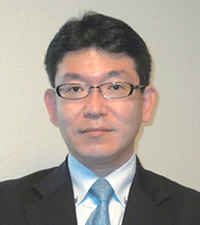Home > About Us > Sustainability Management > Sustainability Report > Sustainability Report 2013 > Third-party Comment
 Third-party Comment
Third-party Comment
Comments on Reading the Kobe Steel Group's Sustainability Report 2013

Keisuke Takegahara,
General Manager,
Environmental Initiative & Corporate
Social Responsibility Support
Department,
Development Bank of Japan
PROFILE
Keisuke Takegahara graduated from Hitotsubashi University Faculty of Law and joined Japan Development Bank (now Development Bank of Japan) in 1989. He worked as Deputy Director of the Policy Planning Department (in charge of planning environmental investment), and as Manager of the CSR Promotion Office (Business Development Department) before being appointed to his current position. His previous posts have included part-time graduate school lecturer at the University of Tokyo, member of the Ministry of Economy, Trade and Industry's Study Committee on the Evaluation of Environmental Capabilities in the Financial Market, and member of the Ministry of the Environment's Review Committee for Industries and Services subject to Surveys into the Scale of Environmental Business Markets and Employment. Since 2009, he has also been a member of the Central Environmental Council General Policy Committee's Specialist Committee on Finance and the Environment.
In the Kobe Steel Group Sustainability Report 2013, the Group has made new efforts to deepen communication while following its concept of CSR management, clarified in last year’s report, as "contributing to society through monozukuri (manufacturing)."
First of all, the message from President Kawasaki at the start of the report sets out a direction for group management and adds a fresh perspective through references to individual technologies and various initiatives related to CSR. On top of this, the description of environmental activities and social contribution activities from three perspectives based on materiality, coupled with the more compact format overall, gives a stronger coherence to the Kobe Steel Group’s vision of CSR management.
In the individual sections, I was impressed with the way in which, while maintaining a system focused on clarity, the report provides opportunities through the incorporation of new environmental and social information for readers of past reports to deepen their understanding of CSR management. Initiatives in the value chain were mentioned for the first time in the environmental report section. It may be said that showing upstream initiatives in the supply chain is an important first step in revealing more clearly the degree of the group’s contributions. That this is so is precisely because the Kobe Steel Group provides society with diverse value, developing and supplying a wide range of materials and systems, in addition to quality steel, on a number of fronts.
The social report section included a special feature on the contributions to society made through sport by the Kobe Steel Rugby Club. I felt that the special feature effectively highlighted the diversity of the Kobe Steel Group’s social contribution activities by focusing on the uniqueness of the Group’s contributions, such as rugby players’ support for disaster-afflicted areas and training of the next generation through rugby workshops. This is a different angle from that taken in previous reports, which tended to discuss business sites’ harmony with local communities around the world.
Once again the Kobe Steel Group deserves to be praised for producing a report with a high level of finish, one that arranges CSR activities from various aspects based on its own concept. I hope that in the future the Group will deepen the relationships between business units and further improve integration. For instance, initiatives in the value chain, which were added to the report this year, will lead to showing the relationship between the Group’s core business and biodiversity in greater detail, such as in the mining and transport of resources. I hope that the Group will more clearly show that it makes substantial contributions to the preservation of natural capital through technology while it depends on ecosystem services. I also hope to see reported in the social report section the handing down of skills and knowledge to the next generation in the world of manufacturing, as a continuation from this report, which revealed the transmission of culture through sports. It has been pointed out that insufficient sharing of technology and know-how on the manufacturing floor is a cause of the recent frequent occurrence of accidents. Given this state, I think that showing a commitment to educating the next generation, which will come to underpin manufacturing, the Group’s main business, with a focus on the key concepts of safety and business continuity capability, would be an extremely important report from a social dimension.
I expect that the Group will make use of its highly developed systems to further enhance the Sustainability Report as a tool for communication with diverse stakeholders.


